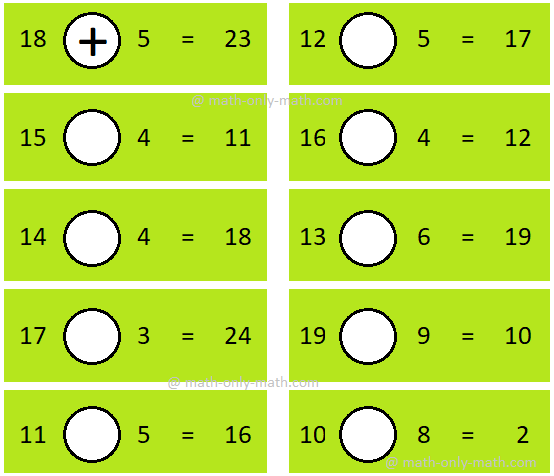Subscribe to our ▶️ YouTube channel 🔴 for the latest videos, updates, and tips.
Addition or Subtraction
Here we will learn how to identify whether it is addition or subtraction upto 20.
Addition and subtraction are the two basic arithmetic operations where we learn how to add and subtract two or more numbers. The symbol to denote addition is ‘+’ (plus sign) and subtraction is ‘-’ (minus sign).
Both addition and subtraction are the opposite operations of each other. We use these arithmetic operations in mathematics to calculate the sum and difference between the numbers.
For example, if 10 + 1 = 11, here we added 10 and 1 to get 11
That shows the result is 11 and it is increased by 1.
Whereas, 10 – 1 = 9, here we subtracted 1 from 10 and we get 9.
That shows the result is 9 which is reduced by 1.
For example:
1. 13 ☐ 2 = 15
Here we see one number is 13 and the other number is 2 which is equal to 15.
15 is the increased number by adding two numbers i.e. 13 and 2. Since, the result is more than the two numbers then we need to add and check. 13 + 2 = 15. So, we need to put the ‘+’ (plus sign) in the box.
2. 11 ☐ 3 = 8
Here we see one number is 11 and the other number is 3 which is equal to 8.
Subtraction means reducing and 8 is the reduced number than the first number 11. Since, the result is less than the given numbers then we need to subtract and check. That shows, 11 - 3 = 8. So, we need to put the ‘-’ (minus sign) in the box.
Now we will understand few examples to check whether we should use (+) sign i.e. addition or (-) sign i.e. subtraction in the boxes.
Let us follow the same rules and complete the following.
Addition or Subtraction upto 20:
1. Put '+' or '-' in the circle. One has been done for you.
2. Word Problems on Addition or Subtraction upto 20: One has been done for you.
(i) There are 12 bottles of mango jam and 6 bottles of apple jam in the shop.
There are 18 jam bottles in the shop. 12 + 6 = 18
(ii) James had 16 colour pencils with him. He gave 3 colour pencils to his friend.
Raj has _____ colour pencils left with him. 16 ..... 3 = _____
(iii) There are 5 bottles of cola and 7 bottles of orange in the crate.
There are _____ bottles in the crafe. 5 ..... 7 = _____
(iv) A Fruit seller had 18 bananas with him, 5 were rotten. He threw away the rotten ones.
He has _____ bananas left with him. 18 ..... 5 = _____
Addition or Subtraction upto 100:
3. Write addition or subtraction sign in the red blanks.
i.e., put '+' or '-' in the red blank. One has been done for you.
(i) 65 + 6 = 71
(ii) 48 ..... 7 = 41
(iii) 53 ..... 9 = 44
(iv) 81 ..... 9 = 90
(v) 34 ..... 3 = 37
(vi) 79 ..... 2 = 77
4. Fill in the boxes correctly using the concept of Addition or Subtraction. One has been done for you.
(i) 59 - 7 = 52
(ii) 35 + ▢ = 39
(iii) 64 - ▢ = 60
(iv) ▢ + 5 = 58
(v) ▢ - 3 = 68
(vi) 72 - ▢ = 64
First Grade Math Activities
From Picture Addition to HOME PAGE
Didn't find what you were looking for? Or want to know more information about Math Only Math. Use this Google Search to find what you need.



New! Comments
Have your say about what you just read! Leave me a comment in the box below. Ask a Question or Answer a Question.